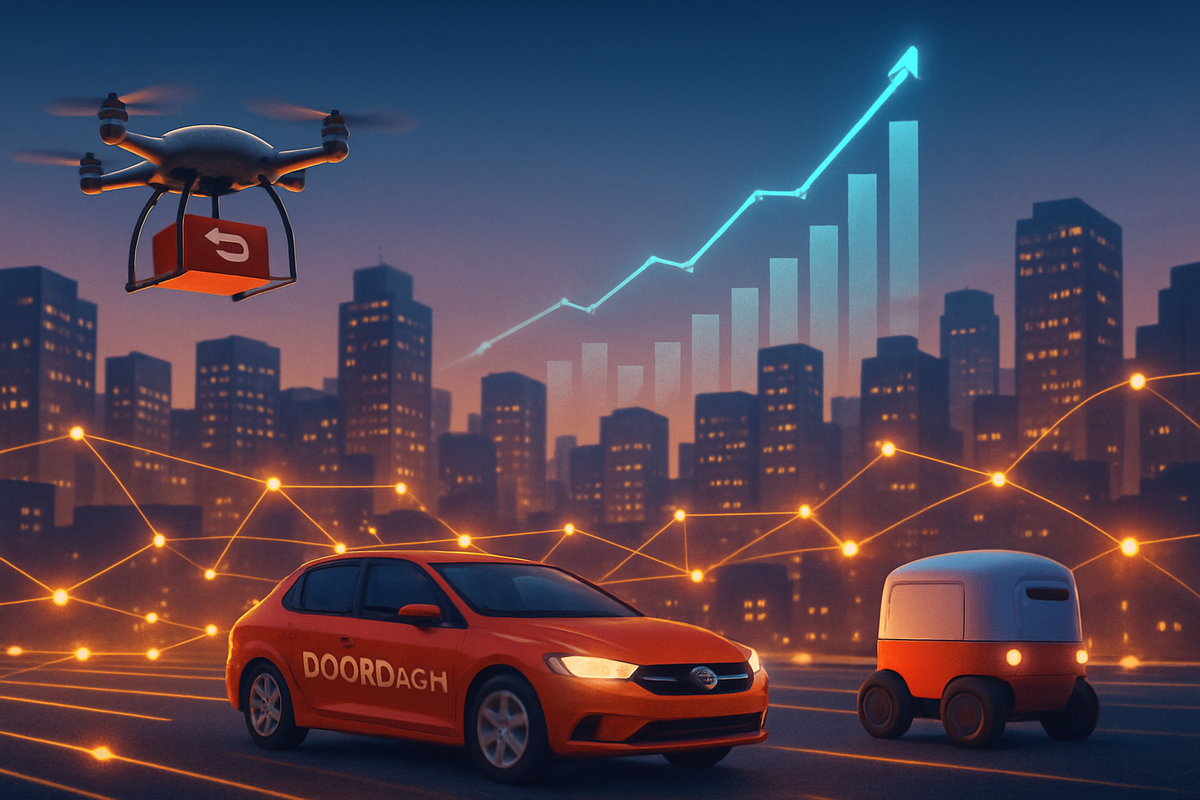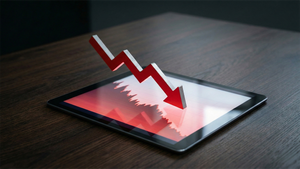
DoorDash Inc. (NYSE: DASH), the dominant force in on-demand local commerce, is currently riding a wave of positive momentum. The company's stock has surged following a series of strategic multi-year agreements and initiatives, including a significant partnership with Criteo to bolster its retail media capabilities, an expansive deal with Kroger (NYSE: KR) that makes it the largest grocer on the platform, and an extended global partnership with Domino's (NYSE: DPZ) in Canada. These developments, coupled with strong financial results including its first-ever annual profit in 2024 and robust performance in 2025, underscore DoorDash's successful diversification beyond traditional restaurant delivery and its solidifying position in the broader commerce landscape.
However, amidst this backdrop of accelerated growth and increasing profitability, a hypothetical yet profound question emerges: What if DoorDash, traditionally a quintessential growth stock, were to declare a dividend? Such a move would represent a monumental strategic shift, signaling not just strong profitability, but a mature commitment to returning capital to shareholders beyond mere growth. This report delves into the potential implications of such a declaration, examining its impact on DoorDash, its competitors, and the wider market.
DoorDash's Ascent and the Hypothetical Dividend Catalyst
DoorDash's journey from a Palo Alto startup in 2012 to a multi-billion dollar public entity has been marked by relentless expansion and strategic innovation. The company's recent positive news highlights its aggressive push into new verticals and geographies. On October 6, 2025, DoorDash announced a multi-year partnership with Criteo, a global advertising technology firm, aimed at significantly expanding its retail media capabilities, particularly in non-restaurant categories like grocery and CPG. This collaboration is expected to broaden advertising avenues for brands and agencies across DoorDash's various ad formats and off-site channels. Just days prior, on September 30, 2025, DoorDash unveiled a major expansion of its partnership with Kroger, integrating nearly 2,700 Kroger stores onto its platform, making it the largest grocer available. This move, alongside the introduction of a "Going Out" tab for restaurant reservations and the expansion of its "Dot" autonomous delivery robots, underscores DoorDash's ambition to become the operating system for local commerce. Additionally, an extended partnership with Domino's Pizza of Canada, announced on October 6, 2025, further solidifies its international footprint.
These initiatives build upon a robust timeline of growth. After its IPO in December 2020, DoorDash capitalized on the pandemic-driven surge in demand, rapidly expanding its market share and acquiring international players like Wolt and Deliveroo. Crucially, 2024 marked a turning point with DoorDash reporting its first-ever annual profit of $117 million on revenues of $10.72 billion, a testament to its scaling advertising business and diversified offerings. This profitability has continued into 2025, with Q1 and Q2 reporting GAAP net incomes of $193 million and $285 million respectively, alongside significant increases in revenue and Adjusted EBITDA. This consistent financial health is what makes the hypothetical discussion of a dividend pertinent.
Key stakeholders in DoorDash's success include its co-founders Tony Xu, Andy Fang, and Stanley Tang, along with a diverse Board of Directors. Institutional investors like Vanguard Group Inc. and BlackRock, Inc. hold significant stakes, alongside a substantial base of retail investors. The vast network of Dashers (delivery drivers) and a growing number of merchants and consumers are also integral to the company's ecosystem.
The market has reacted favorably to DoorDash's recent announcements. The Criteo partnership saw DoorDash's stock (DASH) jump 4.3% on October 6, 2025, while the Kroger expansion and other initiatives on September 30, 2025, led to a 4% rise in shares. Overall, the stock has performed strongly, hitting a 52-week high in early July 2025 and showing a 90.04% increase over the past year, reflecting investor optimism. However, it is important to note that DoorDash has historically stated in its IPO filing that it does not anticipate declaring or paying cash dividends, intending to retain all earnings for growth.
In the hypothetical scenario of a dividend declaration, the market reaction would be multifaceted. Such a move would fundamentally alter investor perception, signaling a transition from a pure growth-oriented company to one that is mature enough to consistently return capital. While this could attract value investors seeking income, it might also prompt some traditional growth investors to re-evaluate their positions, concerned about a potential slowdown in aggressive expansion or a reallocation of capital away from high-growth opportunities. A dividend would undeniably confirm DoorDash's sustained profitability and robust free cash flow, but it would also necessitate a careful balance between shareholder distributions and continued investment in the strategic initiatives that have driven its growth to date.
Shifting Tides: Winners and Losers in the Wake of a DoorDash Dividend
A hypothetical dividend declaration by DoorDash (NYSE: DASH) would send a clear signal of maturity and sustained profitability, profoundly impacting its own investor base and reshaping the competitive landscape for its rivals and the broader gig economy. For DoorDash itself, such a move would be a double-edged sword. It would undoubtedly attract a new segment of income-focused investors, who prioritize steady returns and view dividend-paying companies as more financially stable. This could broaden its shareholder base and potentially stabilize its stock price during market volatility. However, it might also lead to a re-evaluation by some traditional growth investors who prefer to see all earnings reinvested for aggressive expansion. The dividend would serve as a powerful validation of DoorDash's business model, confirming its ability to generate robust free cash flow and sustainable profits, a significant achievement for a company once viewed through a "growth-at-all-costs" lens.
For its primary competitor, Uber Eats (NYSE: UBER), a DoorDash dividend would exert considerable competitive pressure. Uber (NYSE: UBER) has itself demonstrated consistent profitability across its diverse segments, including its growing delivery arm, and has recently authorized a significant share repurchase program. However, a DoorDash dividend could prompt investors to push Uber Eats to demonstrate its own capacity for direct capital returns, potentially accelerating its focus on operational efficiency and the "super app" strategy to leverage its broader ecosystem. While Uber might not immediately follow with a dividend for its delivery segment, the move would intensify the scrutiny on its standalone delivery profitability and cash flow generation.
Grubhub, now part of Wonder Group, would face an even more challenging scenario. Having been acquired at a substantial discount and projected to experience weaker EBITDA and free cash flow deficits in 2025 and 2026, Grubhub is in a rebuilding phase. A DoorDash dividend would starkly highlight Grubhub's struggles with profitability and market share, making a similar capital return strategy highly improbable for the foreseeable future. Grubhub would likely double down on cost-saving initiatives and focus on specific niche markets where it retains strength, such as New York City, to improve its financial health.
Beyond direct competitors, a DoorDash dividend would send ripples across the entire gig economy and e-commerce sectors. It could establish a significant precedent for other gig economy companies nearing or achieving profitability, such as Instacart (NASDAQ: CART), which has reported consistent net income. These companies might face increased investor expectations to follow suit with their own capital return strategies. This shift would create a clearer distinction between "growth-at-all-costs" gig platforms and those that have matured into cash-generating entities, attracting a broader base of income-focused investors to the sector. For companies in the broader e-commerce and logistics ecosystem, a DoorDash dividend would signal stabilization and profitability in last-mile delivery, potentially encouraging further investment in related infrastructure and technologies, validating the long-term viability of these models.
Wider Significance: A Bellwether for the Maturing Gig Economy
A hypothetical dividend declaration by DoorDash would resonate far beyond its immediate financial statements, serving as a significant bellwether for the maturation of both the food delivery and broader gig economy industries. This event would underscore a fundamental shift from a "growth-at-all-costs" mentality towards a model that balances aggressive expansion with demonstrable profitability and shareholder returns. The industry is already undergoing a transformation, with trends such as AI-powered personalization, intense focus on operational efficiency, and a significant diversification into grocery and other retail deliveries. The gig economy itself is expanding rapidly, with projections indicating a substantial portion of the U.S. workforce engaging in gig work by 2025, alongside a growing demand for highly skilled contract roles. A DoorDash dividend would signal that even in these dynamic sectors, companies can achieve the financial stability required to reward shareholders, validating the long-term viability of these business models.
The ripple effects would be felt across the ecosystem. For competitors, the pressure to demonstrate their own paths to consistent profitability and potential capital returns would intensify. While some, like Uber Eats (NYSE: UBER), are already engaging in share buybacks, a DoorDash dividend would set a new benchmark for financial maturity. For DoorDash's partners, particularly restaurants, a financially robust and dividend-paying platform could be seen as a more reliable long-term ally, potentially leading to continued investment in technology and infrastructure that benefits merchants. However, the most profound and potentially contentious ripple effect would be on DoorDash's vast network of drivers, or Dashers. If DoorDash were to declare a dividend while continuing to classify its drivers as independent contractors, it would significantly amplify public and regulatory calls for improved worker compensation, benefits, or even a reclassification of drivers as employees. The company's demonstrated financial capacity through a dividend would make arguments against better worker conditions considerably harder to defend, further fueling the ongoing debate around gig worker rights and fair labor practices, a trend underscored by recent settlements regarding tipping practices.
From a regulatory and policy perspective, a DoorDash dividend could have several implications. It would validate the company's strong financial health and consistent cash flow, potentially empowering regulators to argue that such companies have the capacity to comply with stricter labor laws, contribute more in taxes, or adhere to more robust operational standards. The worker classification debate, already a contentious issue, would likely intensify, with legislative efforts aimed at mandating comprehensive portable benefits or even reclassifying gig workers. Furthermore, a dividend from a dominant tech player could reignite discussions around corporate tax structures and potentially invite greater antitrust scrutiny if perceived as a result of unchecked market dominance.
Historically, the tech sector has seen a growing number of former high-growth companies transition to paying dividends. Major tech giants like Alphabet (NASDAQ: GOOGL) and Meta (NASDAQ: META) initiated their first-ever dividends in 2024, receiving enthusiastic market responses. Companies like Microsoft (NASDAQ: MSFT), Apple (NASDAQ: AAPL), and IBM (NYSE: IBM) have long histories of consistently paying and increasing dividends, demonstrating that shareholder payouts are not incompatible with continued innovation and growth. These precedents suggest that a DoorDash dividend would be interpreted by the market as a strong signal of management's confidence in the company's sustained profitability and future cash flow generation, attracting a more diverse investor base beyond those solely focused on hyper-growth. This move would firmly position DoorDash within the ranks of mature, financially disciplined technology leaders.
What Comes Next: Navigating the Crossroads of Growth and Returns
Should DoorDash (NYSE: DASH) indeed declare a dividend, the company would embark on a new and complex phase, necessitating careful strategic navigation and transparent communication. In the short term, the market's initial reaction would likely be mixed. While income-focused investors might view it as a positive sign of financial stability and maturity, potentially driving immediate demand, some growth investors might interpret it as a signal of slowing hyper-growth, leading to selling pressure. For DoorDash, a dividend would underscore its confidence in sustained profitability and free cash flow, especially given its recent achievement of consistent GAAP net income and substantial free cash flow generation in 2024 and 2025. Over the long term, a consistent dividend could gradually shift DoorDash's investor base towards a more balanced mix of growth and value investors, potentially stabilizing its stock price. However, it could also prematurely signal a more mature stage of its business lifecycle, potentially capping its perceived long-term growth premium.
Such a strategic pivot would demand several adaptations from DoorDash. The company would need a highly refined capital allocation strategy that explicitly balances dividend payments with continued aggressive investment in its core growth initiatives, including international expansion, new vertical development (grocery, retail media), and technological innovations like autonomous delivery and AI. Maintaining a dividend would necessitate an unwavering focus on sustained and predictable profitability and free cash flow generation, likely leading to even greater emphasis on operational efficiency and monetization across its platforms. Crucially, management would need to articulate a compelling vision for long-term profitable growth that seamlessly coexists with shareholder payouts, perhaps emphasizing high-margin opportunities rather than just top-line expansion. Careful debt management, especially given recent large acquisitions like Deliveroo and convertible notes offerings, would also be paramount.
The declaration of a dividend would open up new market opportunities while simultaneously presenting significant challenges. On the opportunity front, DoorDash could broaden its appeal to institutional investors and funds with mandates for dividend-paying stocks, potentially increasing demand and stabilizing its valuation. If the market re-rates DoorDash as a more mature, stable company, it could reduce stock volatility and even position it as a more defensive play in uncertain economic climates. However, challenges abound. A dividend might dilute DoorDash's powerful growth narrative, making it harder to attract or retain investors solely interested in high-growth, disruptive companies. Competitors not paying dividends might gain a competitive advantage by reinvesting a greater portion of their earnings, potentially allowing them to out-innovate or expand faster. Moreover, the dividend could intensify regulatory scrutiny on DoorDash's pricing practices for consumers and merchants, and critically, on its compensation and classification of Dashers, particularly if the payout is perceived to come at the expense of fair labor practices.
Considering these dynamics, several scenarios for DoorDash's stock performance could unfold. In a "Mature Growth" scenario, DoorDash successfully communicates that the dividend reflects financial strength and efficiency, not a halt in growth. The stock experiences brief volatility, then stabilizes and sees gradual appreciation as a "mature growth" stock with reliable income. A "Growth Slowdown" scenario, conversely, would see the market interpret the dividend as the end of hyper-growth, leading to a significant sell-off and a struggle to recover. The most optimistic "Balanced & Confident" scenario would involve DoorDash declaring a modest, sustainable dividend while explicitly reaffirming its commitment to continued aggressive, profitable growth. In this outcome, the market views the move as a sign of exceptional financial health and strategic foresight, with the stock maintaining its growth momentum while also gaining a "quality" premium, appealing to an even broader investor base. Given DoorDash's current trajectory of aggressive expansion and recent profitability, a dividend declaration would be a bold, calculated move, signaling immense confidence in its future cash-generating ability and a potential redefinition of its investment profile.
Comprehensive Wrap-Up: A New Era for DoorDash and the Gig Economy
A hypothetical dividend declaration from DoorDash (NYSE: DASH), while not currently in its stated plans, would mark a profound inflection point for the company and the broader gig economy. The key takeaway from such a move would be its unequivocal signal of financial maturity and sustained profitability. Having achieved its first annual GAAP net income in 2024 and demonstrating robust financial performance through 2025, a dividend would underscore management's confidence in its ability to generate consistent free cash flow beyond its aggressive reinvestment needs. This would invariably shift investor perception, attracting a new cohort of income-focused investors and potentially leading to a more diversified and stable shareholder base, aligning DoorDash with the growing trend of established tech giants like Alphabet (NASDAQ: GOOGL) and Meta Platforms (NASDAQ: META) that have recently initiated dividends.
Looking ahead, the food delivery market is poised for continued robust growth, driven by an insatiable demand for convenience, increasing smartphone penetration, and ongoing urbanization. However, this expansion will occur within an intensely competitive landscape where DoorDash currently holds a dominant position. Diversification into new verticals like grocery, convenience, and retail, alongside aggressive international expansion, will remain crucial for sustained growth. Technological advancements, particularly in AI-powered logistics and autonomous delivery, will continue to drive efficiency and differentiation. Yet, the industry will also face persistent regulatory pressures, especially concerning gig worker classification and fair compensation, which could significantly impact operational costs and business models.
The lasting impact of a DoorDash dividend would be multifaceted. It would significantly expand the company's investor base, potentially increasing institutional ownership and providing more stable demand for its stock. More importantly, it would serve as a powerful validation of the underlying business model's ability to generate sustainable profits, moving beyond the "growth-at-all-costs" narrative often associated with nascent tech companies. This could enhance DoorDash's corporate reputation and credibility, signaling prudent financial management alongside its ambitious growth strategy. While often associated with slower growth, a dividend could lead to a re-rating of DoorDash's valuation multiples, as the market places a premium on stable, dividend-paying companies.
In the coming months, investors should closely monitor several critical factors concerning DoorDash and its peers. The sustainability of DoorDash's profitability and free cash flow will be paramount for any potential dividend program. The performance of its new verticals and recently expanded international operations will be crucial indicators of its continued growth trajectory and diversification success. Competitive responses from rivals like Uber Eats (NYSE: UBER) and Grubhub, including their own moves towards shareholder returns or new market entries, will shape the competitive dynamics. Furthermore, any new regulatory developments concerning gig worker rights, minimum wages, or platform fees will directly impact the operational costs and profitability of all players in the sector. Finally, continued innovation in automation and AI, coupled with judicious capital allocation decisions—balancing growth investments with potential shareholder returns—will define DoorDash's path forward in this evolving market.
This content is intended for informational purposes only and is not financial advice







